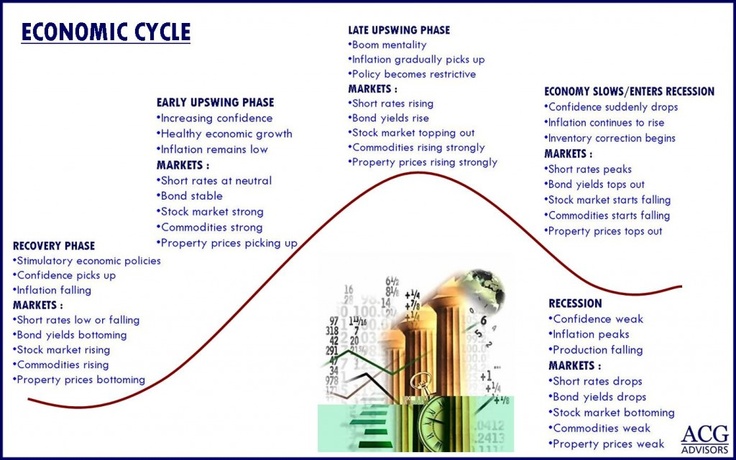Understanding Market Cycles and Economic Indicators
A Beginner's Guide to Better Investment Timing
MARKET ANALYSIS
Ben T.
6/24/20254 min read


The concept of Market Cycles and Economic Indicators
Market cycles and economic indicators might sound like complex Wall Street jargon, but they're actually powerful tools that can help you make smarter investment decisions. Think of them as the financial world's weather forecast – they help you understand what's happening now and what might be coming next.
Whether you're just starting your investment journey or looking to refine your strategy, understanding these concepts will give you a significant edge in navigating the markets with confidence.
What Are Market Cycles?
Market cycles are the natural rise and fall patterns that financial markets experience over time. Just like the seasons change predictably throughout the year, markets go through distinct phases that repeat over longer periods. These cycles are driven by investor psychology, economic conditions, and various external factors.
The Four Phases of Market Cycles
1. Accumulation Phase This is the market's "winter" – a period when prices have bottomed out and smart money begins to quietly buy assets. Most investors are still pessimistic from the previous downturn, creating opportunities for those willing to invest when others are fearful. Trading volumes are typically low, and negative sentiment dominates headlines.
2. Markup Phase (Bull Market) As confidence slowly returns, prices begin to rise consistently. This is the market's "spring and summer" – a time of growth and optimism. More investors start participating, driving prices higher. This phase can last months or even years, creating substantial wealth for those who positioned themselves early.
3. Distribution Phase The market reaches its peak during this phase. Experienced investors begin taking profits while new investors, attracted by recent gains, continue buying. This creates a tug-of-war between buyers and sellers. Volatility often increases as the market becomes uncertain about its direction.
4. Markdown Phase (Bear Market) This is the market's "autumn and winter" – a period of declining prices and growing pessimism. Fear replaces greed as the dominant emotion, and investors rush to sell their holdings. This phase continues until prices reach attractive levels that draw in value-focused investors, starting the cycle anew.
Key Economic Indicators Every Investor Should Know
Economic indicators are statistics that provide insights into the overall health and direction of the economy. They're like vital signs for the economic body – helping you understand whether the economy is growing, contracting, or stable.
Leading Indicators: Crystal Balls of the Economy
Leading indicators change before the economy starts following a particular trend, making them valuable for predicting future economic activity.
Employment Data The unemployment rate and job creation numbers are among the most watched indicators. When unemployment is low and jobs are being created, it typically signals economic strength. People with jobs spend money, driving economic growth and often boosting stock prices.
Stock Market Performance Ironically, the stock market itself is a leading indicator. Markets often anticipate economic changes months in advance, as investors buy and sell based on their expectations of future conditions.
Consumer Confidence Index This measures how optimistic consumers feel about the economy and their personal financial situation. High consumer confidence often leads to increased spending, which drives economic growth.
Yield Curve The yield curve shows the relationship between interest rates and bonds of different maturities. When long-term rates are higher than short-term rates (normal curve), it suggests economic growth. An inverted yield curve, where short-term rates exceed long-term rates, has historically preceded recessions.
Coincident Indicators: Real-Time Economic Health
These indicators change at the same time as the overall economy, providing a snapshot of current conditions.
Gross Domestic Product (GDP) GDP measures the total value of goods and services produced in a country. It's the ultimate scorecard for economic performance. Growing GDP indicates a healthy economy, while declining GDP suggests problems.
Industrial Production This tracks the output of factories, mines, and utilities. Rising industrial production suggests strong demand and economic growth, while declining production may signal economic weakness.
Personal Income and Spending These measures show how much money people are earning and spending. Strong income growth and healthy spending patterns indicate economic vitality.
Lagging Indicators: Confirming the Trend
Lagging indicators change after the economy has already begun following a particular trend. They help confirm what has already happened.
Inflation Rates Measured by the Consumer Price Index (CPI), inflation shows how much prices are rising. Moderate inflation is normal in a growing economy, but high inflation can signal overheating, while deflation may indicate economic weakness.
Corporate Earnings Company profits reflect economic conditions but are reported after the fact. Strong earnings across multiple sectors suggest a healthy economy, while widespread earnings declines may confirm economic troubles.
How to Use Market Cycles and Economic Indicators in Your Investment Strategy
Understanding these concepts is only valuable if you can apply them to make better investment decisions. Here's how to put this knowledge to work:
Timing Your Market Entry and Exit
While timing the market perfectly is impossible, understanding cycles and indicators can help you make more informed decisions about when to increase or decrease your market exposure.
During the accumulation phase, when negative sentiment is high but economic indicators are starting to improve, consider gradually increasing your stock allocation. This is when Warren Buffett's famous advice to "be fearful when others are greedy and greedy when others are fearful" applies most directly.
As markets enter the distribution phase and economic indicators show signs of overheating (such as very low unemployment, high consumer confidence, and stretched valuations), consider taking some profits and reducing risk.
Sector Rotation Strategies
Different sectors perform better at different stages of the economic cycle. Understanding these patterns can help you position your portfolio accordingly:
Early Cycle: Technology and consumer discretionary stocks often lead
Mid Cycle: Industrial and materials companies typically perform well
Late Cycle: Energy and financial stocks may outperform
Recession: Utilities, consumer staples, and healthcare tend to be more defensive
Check this post to learn more about Rotation Strategies
Building a Balanced Approach
Remember that no single indicator tells the complete story. Successful investors look at multiple indicators together to form a comprehensive view. Create your own "dashboard" of key indicators that you monitor regularly, but don't make dramatic portfolio changes based on short-term fluctuations in any single metric.
The most important lesson is that market cycles are inevitable – markets will rise and fall regardless of short-term noise. By understanding these patterns and staying disciplined in your approach, you can position yourself to benefit from the market's natural rhythms while avoiding costly emotional decisions.
Economic indicators and market cycles are tools, not crystal balls. Use them to inform your decisions, but always maintain a long-term perspective and never invest more than you can afford to lose. The investors who succeed over time are those who understand these concepts but don't let them drive them to constant trading or market timing attempts.
Instead, use this knowledge to stay informed, maintain perspective during volatile periods, and make gradual adjustments to your portfolio as conditions change. This measured approach, combined with consistent investing and patience, forms the foundation of successful long-term wealth building.


